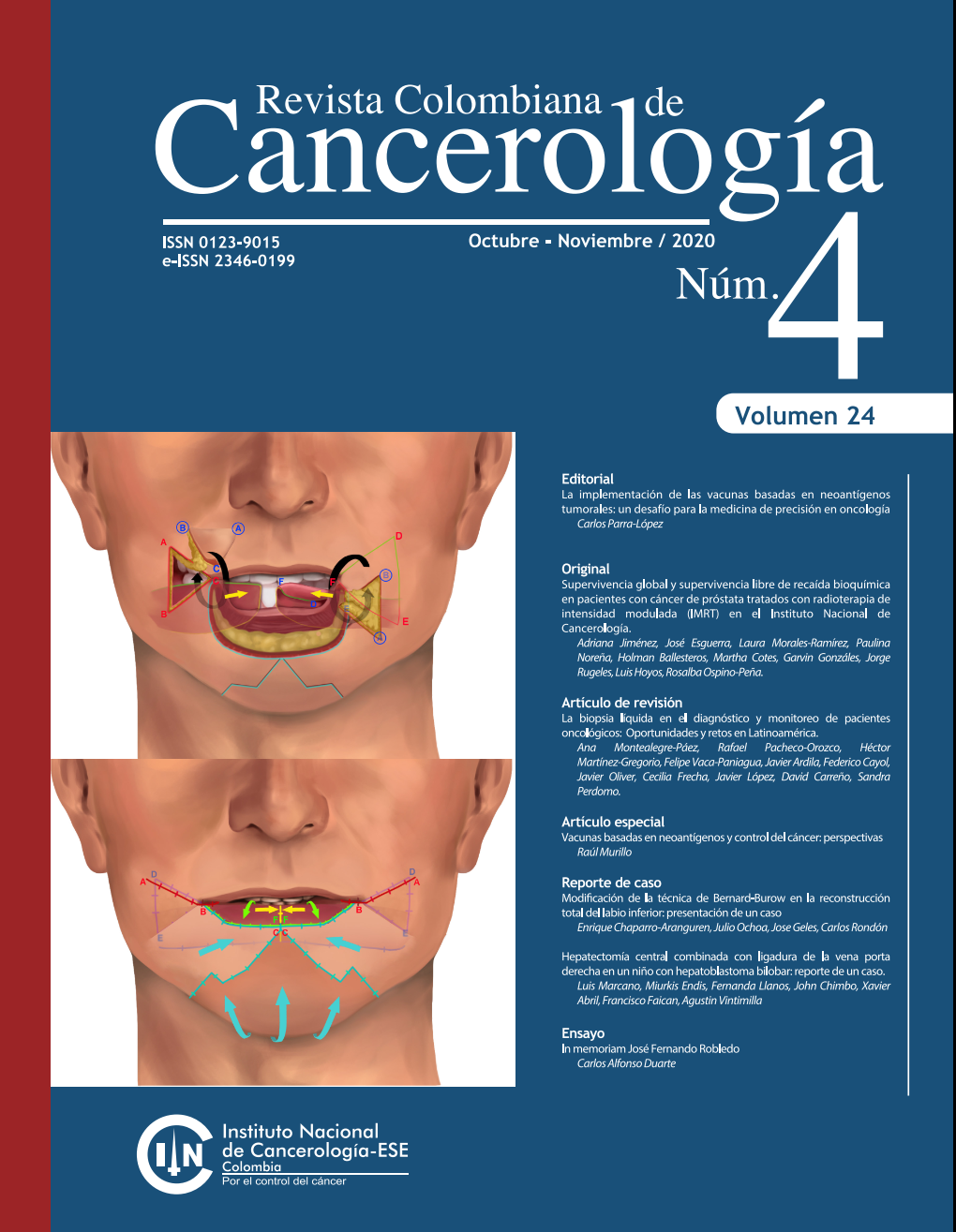Global survival and biochemical relapse-free survival in patients with prostate cancer treated with intensity modulated radiotherapy (IMRT) at the National Cancer Institute.
DOI:
https://doi.org/10.35509/01239015.6Keywords:
Prostatic Neoplasms, Radiotherapy, Intensity-Modulated Radiation TherapyAbstract
Abstract
Background: In 2018, prostate cancer ranked second in incidence worldwide. Advances in technology and the appearance of intensity-modulated radiotherapy, have made it possible to reduce doses to healthy tissue without reducing the coverage of the target volume, thus allowing lower morbidity associated with radiotherapy and the possibility of scaling the treatment dose. The aim of the study was to present the results in overall survival and biochemical relapse-free survival at the Colombian National Cancer Institute (INC) in patients diagnosed with non-metastatic prostate cancer treated with intensity-modulated radiotherapy (IMRT).
Material and methods: The retrospective review included 98 patients over 40 years of age with prostate cancer, without evidence of metastatic disease, treated with IMRT between 2008 and 2015 irrespective of androgenic suppression. The administered dose of radiotherapy varied according to their risk based on the D'Amico classification.
Results: The median age was 68.5 years, and of the total of 98 patients, 16 (16%) were classified as low risk, 33 (33%) as intermediate risk, and 49 (50%) as high risk. The mean dose of radiation therapy received was 75.8 Gy. Biochemical relapse-free survival at 5 years was 78.6%, and overall survival was 98%.
Conclusions: In patients with high-risk prostate cancer, IMRT is an effective and safe alternative, with an overall 5-year survival of 98%, and an adequate dosimetric profile for at-risk organs.
References
Allemani C, Matsuda T, Di Carlo V, Harewood R, Matz M, Niksic M, et al. Global surveillance of trends in cancer survival 2000-14 (CONCORD-3): analysis of individual records for 37 513 025 patients diagnosed with one of 18 cancers from 322 population-based registries in 71 countries. Lancet (London, England). 2018;391(10125):1023-75. https://doi.org/10.1016/S0140-6736(17)33326-3
Bray F, Ferlay J, Soerjomataram I, Siegel RL, Torre LA, Jemal A. Global cancer statistics 2018: GLOBOCAN estimates of incidence and mortality worldwide for 36 cancers in 185 countries. CA: a cancer journal for clinicians. 2018;68(6):394-424. https://doi.org/10.3322/caac.21492
Zietman AL, DeSilvio ML, Slater JD, Rossi CJ, Jr., Miller DW, Adams JA, et al. Comparison of conventional-dose vs high-dose conformal radiation therapy in clinically localized adenocarcinoma of the prostate: a randomized controlled trial. Jama. 2005;294(10):1233-9. https://doi.org/10.1001/jama.294.10.1233
Kuban DA, Tucker SL, Dong L, Starkschall G, Huang EH, Cheung MR, et al. Long-term results of the M. D. Anderson randomized dose-escalation trial for prostate cancer. International journal of radiation oncology, biology, physics. 2008;70(1):67-74. https://doi.org/10.1016/j.ijrobp.2007.06.054
Peeters ST, Heemsbergen WD, Koper PC, van Putten WL, Slot A, Dielwart MF, et al. Dose-response in radiotherapy for localized prostate cancer: results of the Dutch multicenter randomized phase III trial comparing 68 Gy of radiotherapy with 78 Gy. Journal of clinical oncology : official journal of the American Society of Clinical Oncology. 2006;24(13):1990-6. https://doi.org/10.1200/JCO.2005.05.2530
Zelefsky MJ, Fuks Z, Hunt M, Lee HJ, Lombardi D, Ling CC, et al. High dose radiation delivered by intensity modulated conformal radiotherapy improves the outcome of localized prostate cancer. The Journal of urology. 2001;166(3):876-81. https://doi.org/10.1016/S0022-5347(05)65855-7
Sheets NC, Goldin GH, Meyer AM, Wu Y, Chang Y, Sturmer T, et al. Intensity-modulated radiation therapy, proton therapy, or conformal radiation therapy and morbidity and disease control in localized prostate cancer. Jama. 2012;307(15):1611-20. https://doi.org/10.1001/jama.2012.460
Zelefsky MJ, Levin EJ, Hunt M, Yamada Y, Shippy AM, Jackson A, et al. Incidence of late rectal and urinary toxicities after three-dimensional conformal radiotherapy and intensity-modulated radiotherapy for localized prostate cancer. International journal of radiation oncology, biology, physics. 2008;70(4):1124-9. https://doi.org/10.1016/j.ijrobp.2007.11.044
Staffurth J. A review of the clinical evidence for intensity-modulated radiotherapy. Clinical oncology (Royal College of Radiologists (Great Britain)). 2010;22(8):643-57. https://doi.org/10.1016/j.clon.2010.06.013
Pardo C, de Vries E, Acero D, Murillo R. Vigilancia de la supervivencia global por cáncer en Colombia: utilidad de los registros rutinarios. Revista Colombiana de Cancerología. 2015;19(2):81-9. https://doi.org/10.1016/j.rccan.2015.03.001
Pardo C, de Vries E. Supervivencia global de pacientes con cáncer en el Instituto Nacional de Cancerología (INC). Revista Colombiana de Cancerología. 2017;21(1):12-8. https://doi.org/10.1016/j.rccan.2017.01.003
Kupelian PA, Willoughby TR, Reddy CA, Klein EA, Mahadevan A. Hypofractionated intensity-modulated radiotherapy (70 Gy at 2.5 Gy per fraction) for localized prostate cancer: Cleveland Clinic experience. International journal of radiation oncology, biology, physics. 2007;68(5):1424-30. https://doi.org/10.1016/j.ijrobp.2007.01.067
Vora SA, Wong WW, Schild SE, Ezzell GA, Andrews PE, Ferrigni RG, et al. Outcome and toxicity for patients treated with intensity modulated radiation therapy for localized prostate cancer. The Journal of urology. 2013;190(2):521-6. https://doi.org/10.1016/j.juro.2013.02.012
How to Cite
Downloads
Downloads
Published
Issue
Section
License
Todos los derechos reservados.





